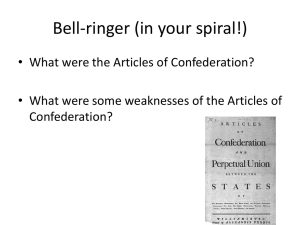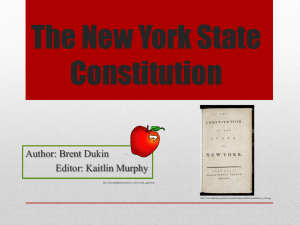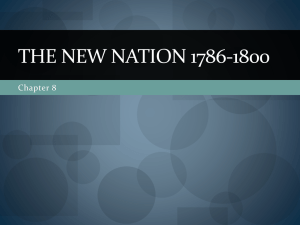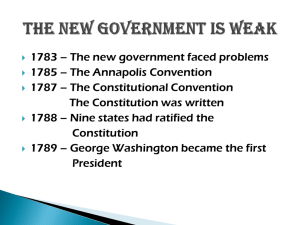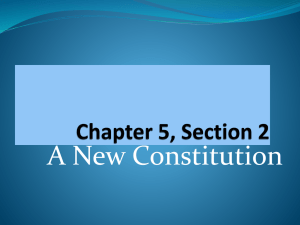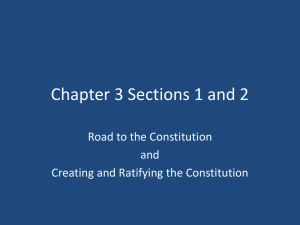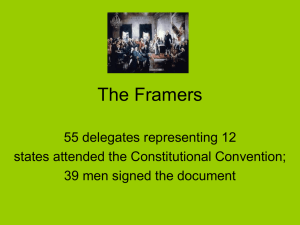Constitutional Era
advertisement
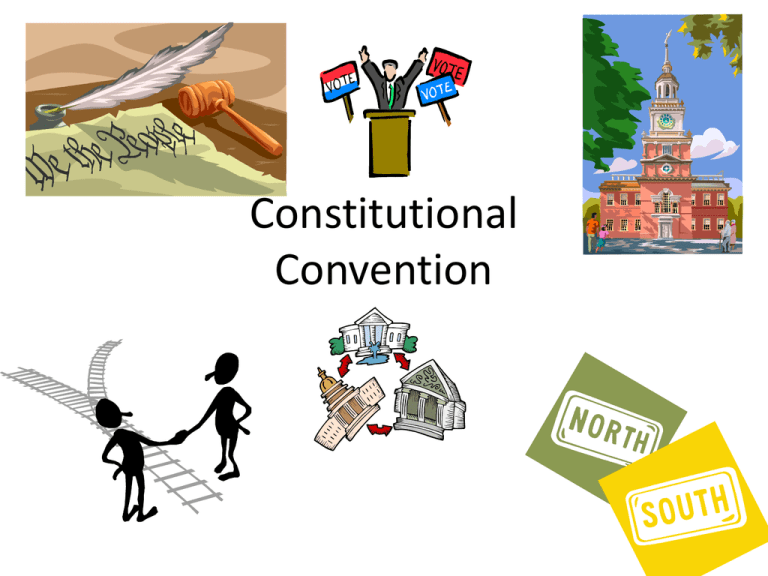
Constitutional Convention Page 78 Look at the picture , then read the quote. What do you think it means??? • "I have often looked at that picture behind the president without being able to tell whether it was a rising or setting sun. Now at length I have the happiness to know that it is indeed a rising, not a setting sun.“ - Ben Franklin Constitutional Era Vocabulary Page 80 Create the chart and sketch pictures depicting the definition of each word Word Definition Preamble An introduction that states the reasons and intent for what follows Constitution The system of basic laws by which a nation or state is governed Ordinance An official rule or law Compromise A settlement of a disagreement in which each side gives up something Republic A nation in which those who make the laws and run the government are elected by the people Sketch Constitutional Era Vocabulary Page 81 Create the chart and sketch pictures depicting the definition of each word Word Definition Congress / Legislature The Branch of Government that makes the laws Amendment An official change made to a law. 2/3 to propose. ¾ to ratify an amendment Founding Fathers Those individuals that were involved in the fight for independence and the forming the new nation Federalists Group of people that supported the Constitution and wanted it approved Anti-Federalists Group of people that did not support the Constitution and did not want it passed without a Bill of Rights added Sketch Chapter 11 ?s page 82 Use the “We the People” book to complete questions about the Articles of Confederation. Articles of Confederation & Northwest Ordinance Page 83 Copy the notes on page 83 Articles of Confederation Weakness: 1. Lacked power to enforce laws 2. Lacked power to regulate trade between states 3. National government not strong, states didn’t want to give up power 4. Required all 13 states approval to make changes Strengths: 1. Kept colonies united during difficult times 2. Organized Northwest Territory by passing the ordinance of 1785 and Northwest Ordinance of 1787. Northwest Ordinance A law passed under the Articles of Confederation that organized the western lands. Under this law territories could: 1. Elect state legislature when the population of adult males reached 5000 2. Apply to be a new state in the US when the population reached 60000 3. Have basic rights to people 4. Not have slavery Path page 84 Parts – 5 things (parts) you see in the picture. No inferences, just what you see. You must be able to put your finger on the item specifically Analyze – Look at each part, what do you think that particular part of the picture represents or why is it there? Title – What do you think would be a good title for this picture? History – How does this picture relate to what you have talked about in class or what you know about History Constitutional Convention Questions? Page 85 1. Use the History Alive Textbook to complete questions about the Constitutional Convention 3. 2. 4. 5. 6. 7. 8. THE CONSTITUTIONAL CONVENTION 1787 Where did the delegates meet? Independence hall; Philadelphia Pennsylvania What was the weather like during the convention? Hot & sticky Who was the president of the convention? George Washington How many delegates were there at the convention? 55 from 12 states Which state did not attend? Rhode Island Which people were not at the convention and why? John Adams and Thomas Jefferson were representatives to Britain/France; Sam Adams, J. Hancock, Patrick Henry did not attend because they feared a strong national government would endanger the rights of the states Why was James Madison important to the Constitution? Father of the Constitution – he took meticulous notes What is the Rule of Secrecy? Agreed not to speak outside the convention about anything that was said until the convention was over. Issue of Representation in Congress Page 86 Complete the worksheet given to you by your teacher. Compromise on Representation page 87 Issue of slavery page 88 Compromise on slavery page 89 Pillars Cartoon page 90 Answer the following questions about the cartoon? 1. What do the pillars represent? 2. How many pillars are holding strong? 3. Which two are crumbling(falling)? 4. Why do you think the pillars are in this order? 5. Why do you think the 2 are not holding strong? Federalists/ Anti-federalists page 91 Use Chapter 8 of the History Alive book to complete the chart. When completed glue on page 91 of your notebook. Questions Federalists Did they support the Constitution? What did they like about the Constitution? Yes Anti-federalists No Created a strong central government Power comes from the people 3 branches of government What did they dislike about the Constitution? Who were the leaders? Madison, Jay , Hamilton Feared too many taxes President would become a king No guaranteed rights of the people State courts swallowed up Mason and Henry Strong central government or strong state governments? Strong central government Strong state governments What reasons did they give to defend their views on ratification? In the Federalist papers, they argued that 3 branches of government would prevent anyone from becoming too powerful Believed that giving up states’ power would and having strong central government would leave the people powerless. Individual rights needed to be protected. Ratification What is the definition of ratify? Approve What needed to be added to the Constitution before it could be ratified? How was the Constitution ratified? Ratified in special conventions • C is for Compromises which were reached in the matters of slavery and representation Convention Acrostic page 92 Use the information you have learned about the Constitutional Convention to complete the Acrostic. Make sure you give detailed information. See example. • • • • • • • • • O is for N is for V is for E is for N is for T is for I is for O is for N is for End of the Convention End of Convention page 93 Copy notes How should the president be picked? The framers did not trust the people and set up a system still in use today called the Electoral College. Most people at this time were unable to get the proper information needed to make an intelligent choice as to who should be president (no TV, radio, internet, etc.), so the framers put in a system to protect the nation from their ignorance. The Electoral College is a group of people called electors that actually vote for president and vice president. The people in the states vote to tell their electors who to vote for. The number of electors is equal to the total number of representatives in Congress (so the larger states have more influence) Constitution approval: 9 states had to ratify for the Constitution to become law. 38 of the 55 delegates signed the Constitution. A new system of federalism was to be started in the United States. A strong national government would share power with the states.
